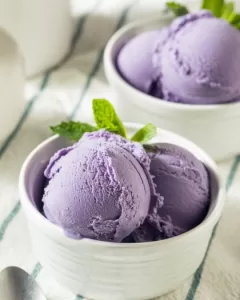Ice Cream: A Chilled Journey Through History and Flavor
Discover the Varieties and Nutritional Value of the World's Favorite Sweet
Ice cream – the mere mention of this frozen treat evokes memories of warm summers and pure joy.
From a simple cone to the most elaborate dessert, ice cream is a universal passion that transcends cultures and eras.
In this article, we invite you to explore the rich history of ice cream, delve into its varied forms and flavors, and understand its nutritional value and place in modern cuisine.
Get ready to discover how this frozen treat became one of the most beloved sweets around the globe.
Origins and History
Although the history of ice cream is hazy, its roots go back to ancient times. There are reports of frozen desserts in ancient China, but it was in 16th century Italy that ice cream began to resemble what we know today.
History of Ice Cream: A Frozen Chronology of Innovation and Delight
The history of ice cream is full of technical innovations and cultural habits. Although we can’t pinpoint exactly when and where ice cream was invented, we can follow a fascinating trail that takes us back to ancient times.

First Frozen Foods (China, 3000 BC)
The predecessors of ice cream can be traced back to ancient China, where snow or ice was mixed with honey and fruit. This delicacy was reserved for the nobility, an exotic luxury far removed from the everyday pleasures of the masses.
Persian refreshments (400 BC)
The Persians also had their own versions of frozen desserts. Yakhchals, ancient structures used to store ice and food, allowed the Persians to enjoy sharbats, or “frozen fruit drinks”, made from fruit juice, water and snow.
Alexander the Great banquet (334-323 BC)
Alexander the Great is said to have feasted on snow flavored with honey and wine, and often stored snow in pits to preserve it during the hot summers.
Roman creations (27 BC-395 AD)
The Romans, led by figures such as Nero, were known for sending slaves into the mountains to collect snow, which was then mixed with fruit and honey, creating a kind of primordial ice cream.
Arab Expansion (7th-11th centuries)
The Arabs expanded the concept of frozen desserts during the Middle Ages, introducing sugar to replace honey. They created sharbat (sorbet), the basis for what would become the ice cream we know today.

Gelato in Renaissance Italy (16th century)
Italy is often cited as the birthplace of modern ice cream. Bernardo Buontalenti, a Florentine confectioner, is credited with introducing gelato to the Medici court. Another important name is that of the Sicilian Procopio Cutò, who opened the Café Procope in Paris and presented an ice cream recipe that combined milk, cream, butter and eggs.
The 17th century and popularization
In the 17th century, the ice cream recipe began to look more like what we know today, with milk, cream, sugar and flavors such as chocolate and fruit becoming commonplace.
The Industrial Age and the Democratization of Ice Cream (19th century)
With the invention of the manual ice cream maker by Nancy Johnson in 1843 and the introduction of industrial refrigeration techniques, ice cream moved away from the exclusivity of the elite and became accessible to the general public.
Ice cream in America and the 20th century boom
In the United States, ice cream was quickly adopted and incorporated into popular culture. The invention of the sundae, the popularization of ice cream parlors and the advent of the ice cream cone – supposedly first introduced at the 1904 St. Louis World’s Fair – all contributed to the American love of ice cream.

Contemporary Innovation and Expansion
In the 20th century, brands such as Baskin-Robbins and Ben & Jerry’s took ice cream to new heights with a variety of innovative and creative flavors. The development of specialty ice creams for diets with dietary restrictions and the growing concern for natural ingredients and artisanal production continue to shape the ice cream industry.
Culinary Varieties and Characteristics
Ice cream comes in a myriad of forms, each with its own distinct characteristics:
Italian Gelato: Less aerated and denser than traditional ice cream, gelato is served at a slightly higher temperature, resulting in a softer texture and more intense flavors. Nutritionally, gelato usually contains less fat than ice cream, as it is made with a higher proportion of milk than cream.
American ice cream: Known for being light and fluffy due to the high amount of air whipped into it, American ice cream is typically higher in fat and sugar, giving it a more indulgent nutritional profile.
Sorbet: Made without dairy products, sorbet is an excellent option for vegans and people with lactose intolerance. It is made from water and fruit, which makes it more refreshing and with a generally lower calorie content.
Frozen Yogurt: Considered by many to be a healthier alternative to traditional ice cream, frozen yogurt contains live cultures of bacteria and generally has less fat. However, it is important to watch the sugar content, which can be high in some commercial recipes.
Soft Serve: This ice cream is served straight from the freezer at a temperature that keeps it soft and creamy. Although it is similar to American ice cream in nutritional terms, the unique texture of soft serve makes it a distinctive experience.
Nutritional value
Ice cream, although an indulgent dessert, varies in its nutritional value.
While fruit sorbet can be a source of vitamins and antioxidants, soft serve ice cream is high in saturated fats and sugars.
The key is conscious consumption and choosing options that balance pleasure and nutrition, such as almond or coconut milk-based ice creams for those looking for low-fat alternatives.
Ice cream is more than a dessert; it’s a cultural institution that offers comfort, celebration and, of course, a treat against the heat.
Its evolution from a mixture of snow and fruit to the vast array of varieties we have today is testament to its timeless appeal.
Combining pleasure and versatility, ice cream can be adapted to suit almost any diet or lifestyle, remaining a perennial favorite on tables and in hearts around the world.
Ice cream today
Today, ice cream is a global industry, enjoyed in all cultures with local variants that reflect the flavors and traditions of each region.
The flavor palette has expanded beyond imagination, incorporating exotic ingredients and unexpected combinations, but also returning to simple, natural formulations that emphasize the quality of the ingredients.
Ice cream and technology (21st century)
In the 21st century, technology and innovation continue to transform the way ice cream is produced and consumed.
High-quality homemade ice cream machines, sustainable production methods and the introduction of personalized flavors through molecular gastronomy techniques are just some of the current trends.
In addition, growing health awareness has encouraged the creation of low-sugar, high-protein and plant-based options, catering to an even wider range of consumers.
Pop Culture and Ice Cream
Ice cream isn’t just a food; it’s a cultural icon. It is present in films, music and literature, symbolizing everything from childhood innocence to adult indulgence.
Ice cream festivals, competitions and celebrations, such as National Ice Cream Day, underline its position as a pillar of popular culture.
Global Impact
The global ice cream industry is a powerful economic force, generating billions in revenue each year and employing thousands in its production and distribution chain.
As brands expand internationally, they adapt their flavors and techniques to suit local tastes, ensuring that ice cream remains a universal yet deeply personal experience.
Cultural Heritage
In places like Turkey, mastic ice cream (dondurma) is known for its elastic texture and theatrical serving technique.
In India, kulfi brings rich, dense flavors, reflecting the spices and essences of the subcontinent. These local variants are not just desserts; they are an integral part of cultural heritage and national identity.
Concluding the story
The history of ice cream is a continuous narrative of innovation, adaptation and celebration.
From its ancient origins to its ubiquitous presence in the modern world, ice cream has transcended its status as a mere dessert to become a symbol of joy, creativity and indulgence.
Whether it’s on a hot summer’s day or gathering around a bowl of ice cream on a cold one, it’s a testament to the human ability to transform the simplest ingredients into moments of pure happiness.
Future prospects
The future of ice cream promises more innovations, with sustainability and personalization at the heart of emerging trends.
As we explore new ways to satisfy our ice cream cravings, one thing is certain: ice cream will continue to be a sweet spot in our lives, a nexus of memories, traditions and innovations that define generations.
Ice cream, in all its cold and delicious forms, remains one of the greatest inventions of human cuisine.